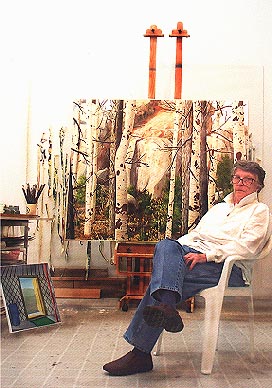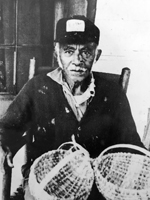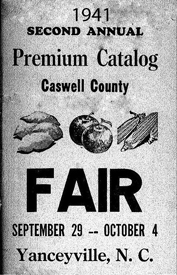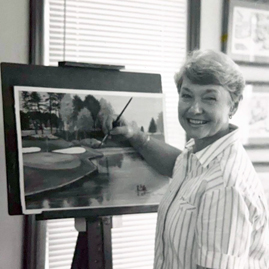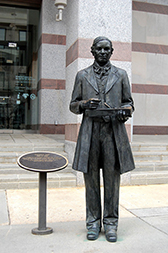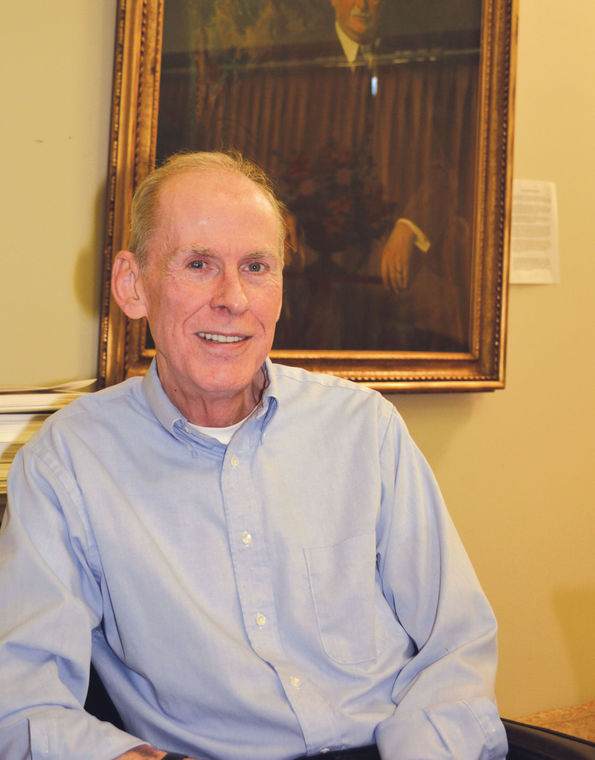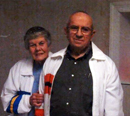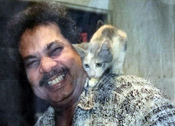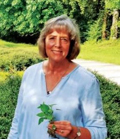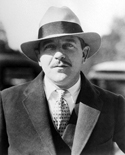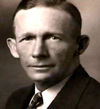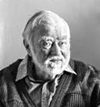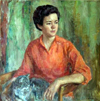Arts and Crafts
Caswell County has produced artists and craftspeople of importance. Below
are biographies, descriptions of their work, and related resources.
Photograph: Maud Florance Gatewood in her studio
To navigate this page click on an item below.
Several silversmiths worked in Caswell County, North Carolina, during the late eighteenth and early to mid nineteenth century. Surviving examples of their work testify to the skills employed. Silversmith Adolphus (Hal) Atkinson (born c.1842 in Caswell County) worked in Milton at some unknown time, but probably after the Civil War, in which he served (Confederate States of America). Mrs. L. B. Satterfield [Mary Yarbrough McAden Satterfield (1911-2003)] of Milton owned three silver tablespoons made by Atkinson that had been in her family for several generations. They bear the mark "Atkinson Milton, N.C."
Source: When the Past Refused to Die: A History of Caswell County North Carolina 1777-1977, William S. Powell (1977) at 130.
Another Atkinson silver spoon is in the collection of the North Carolina Museum of History in Raleigh.
Top
Badgett Sisters (Connie Marie Badgett, Cleonia Ardella Badgett, Celester Badgett)
The Badgett Sisters of Caswell County won a North Carolina Folk Heritage Award in 1990 for singing spirituals, hymns, and gospel songs in the jubilee style, a form of unaccompanied close harmony learned from their father, Cortelyou Odell Badgett (1905-1978). Their albums include Just A Little While to Stay Here and The Voice That Refused to Die. Badgett Sisters Parkway in Caswell County was named in their honor. (Courtesy Connie Badgett Steadman.)
Top
Geter Hunter Bigelow (1894-1980) was born in Caswell County's Leasburg community. However he lived most of his life as a farmer near Milton. His craft was basket weaving. See the 1997 photograph of him displaying two baskets. Completing only the fourth grade he owned his farm. He began crafting white oak split oak baskets at age 17. He related the story of a man that came to his parent's Leasburg home to recane a chair. Bigelow watched the process, concluded he could to the same, and did.
"Bigelow's baskets are used for just what they were meant. They are cured in the sun and dirt of vegetable patches where they hold squash and cucumbers and tomatoes. Smaller models are aged in hen houses. The bushel models hold clothes or whatever the owner can stuff in the confines.
"Year after year local residents come to his house and ask for a basket, a specific basket for a specific job. But the same people don't come very often. An oak split basket can last a lifetime, while their plastic and mesh contemporaries can die in two or three times in a decade.
"After Bigelow has handed over 50 cents to a landowner for the white oak of his choice, he fells it and strips it down to about a six-foot section. The trunk of the close-grained wood is quartered.
"Then he falls to with his Kamp-Knife and from the wood pulls long sections of ribbon-thin splits. Next are the thicker ribs around which the splits will be woven and finally the one-inch wide and one-eighth thick rims that form the basket's shape.
"When the splits have been soaked and are pliant and the rim has been nailed togeth, Bigelow sits down and five hours later has a basket. The results vary from the round-bottomed baskets for vegetables and eggs to the square-bottomed versions.
"The prices are as old-fashioned as the product. A small basket sells for $4, a medium-sized for $6, and a bushel basket for $10. For antique-crazed urban populations who scour flea markets and craft fairs, those prices are a steal. Does Bigelow know that? Does he realize he could do a brisk business at craft fairs."
"'I 'spect I could,' says Bigelow. 'But I ain't got no way to get around. Everybody's so busy they got everywhere to go and nothing to do.'"
Source: "Geter Bigelow: Quiet Craftsman" by David Newton in Greensboro Daily News (Greensboro, NC), 3 Nov 1977.
Top
Top
Harriet was born and raised in rural Caswell County, North Carolina, one of eight girls and three boys. All grew to adulthood, except one girl who died as a toddler. Reading and artistic expression were greatly encouraged in the family, resulting in a strong imagination that enabled Harriet to create with hand and mind.
She cuts directly from her imagination, without patterns or sketches—her work greatly influenced by the experiences of her childhood. Her favorite cuttings illustrate scenes familiar to rural America; often presenting the world from a child's eyes.
Cutting stories from paper has always come easy to Harriet, which is obvious to those who have seen her exhibit. Her husband Lawson was a natural paper cutter as well, and they traveled to arts and crafts shows along the East Coast for more than three decades; demonstrating their unique interpretation of Scherenschnitte to thousands.
Top
The Caswell Council for the Arts was founded in 1977 to celebrate the arts in Caswell County. Since then the Council has kept the arts alive and prospering. The mission is to sponsor and encourage cultural education by increasing art awareness, providing positive opportunities for exposure to the arts, and nurturing local creative expression.
Top
When the first Caswell County Fair was held is not known. However, in the nineteenth century there apparently was a fairgrounds on what today is Dillard School Drive in Yanceyville.
Caswell County Fair (1918): "The Caswell County Fair will be held in Yanceyville, October 1, 2, and 3." Source: Greensboro Daily News (Greensboro, North Carolina), 29 September 1918.
Caswell County Fair (1940): "Miscellaneous prizes [will be given for] model airplanes, terracing drag, farm record account, live at home booth, home made furniture, and display of home-cured meat. The fair is being sponsored by the Rotary Club and will be made an actuality through the cooperation of the various clubs, agricultural groups, and interested citizens. Many midway attractions are scheduled to complement the exhibits and make a fair that will be attractive to all persons in the county." Source: The Herald-Sun (Durham, NC), 22 September 1940. A fair also was held in 1941, but subsequently may have been interrupted by World War II.
The last iteration of the Caswell County Agricultural Fair was begun in 1954 (October 8-13). It was sponsored by the local chapters of the American Legion and the Veterans of Foreign Wars, working with the county's farm organizations. Entries were expected in most of the county's farm crops and many home products. Source: Durham Morning Herald (Durham, NC), 9 September 1956.
This modern version of the fair ran uninterrupted until 2004, falling one year short of fifty years in operation.
Top
Caswell History Speaks was created in 2019 to capture, document, tell (and retell) the rich and valued stories of people connected to Caswell County in a way that fits into the "edu-tainment" model of presenting these stories to as wide an audience as possible. It began when Danvillian Fred Motley wrote a dramatic musical based on the lives of Maud Gatewood, Thomas Day, N. L. Dillard, Neal Watlington, and Henrietta Jeffries. The performance was performed twice at the historic Caswell County Courthouse in Yanceyville and attended by 300 people.
Top
Nancy Jean Poteat Compton (1934-2023) was born in Caswell County, North Carolina, and grew up on her family's farm. The tobacco-growing experience greatly influenced her paintings, many of which were published as postcards:
1. Drawing Plants
2. Planting
3. Laying It By
4. Topping
5. Pulling
6. Stringing
7. Housin' It
8. Sleeping at the Barn
9. Tying
10. The Auction
Top
Statue of famous North Carolina furniture maker Thomas Day at the North Carolina Museum of History in Raleigh. Day, a free black man, moved to Caswell County in 1825 at the age of 24, and quickly became one of the area's most respected and productive furniture makers.
Thomas Day (1801-c.1861), probably the most famous craftsman to call Caswell County home, was born 1801 to free black parents in Dinwiddie County, southeast Virginia. His father was John Day, a farmer and skilled cabinetmaker whose products apparently were well-received in the local market.
His home and shop in Milton,Caswell County, NC, already a National Historic Landmark and on the National Register of Historic Places, has been designated a North Carolina State Historic Site. As such it will join twenty-seven other sites in North Carolina
Top
Mary Elizabeth Moorefield Ellison was born in Caswell County but her gallery and studio is in Bryson City, Swain County, North Carolina. She is an impressionistic painter, whose art expresses how she feels about living in the Smoky Mountains.
Elizabeth often uses some of the earth and sand from mountain streams in her paintings. She also frequently gathers and processes native Appalachian plants to make the handmade paper she uses. The land has nurtured her creativity, and to honor it, she and her husband George have set up a private conservation easement to protect the watershed where they live. Their land is surrounded on three sides by the Great Smoky Mountains National Park.
Top
Top
Harry Lee Fowlkes, Jr. (1949-2016)
After earning a bachelor's degree at Davidson College and a Master of Fine Arts degree at UNC-Greensboro, Harry Lee Fowlkes, Jr., was an artist in residence at Duke University and the North Carolina Arts Council. He wanted to return to his home and family in Caswell County and spent the remainder of his life there. Devoting his life to the arts, he served as Caswell Council for the Arts President and Executive Director as well as Director of Arts in Education for Caswell County Schools. He also served as Director of the Caswell County Civic Center.
Top
Maud Florance Gatewood (1934-2004)
When she died in 2004 Maud Gatewood was arguably the most important living North Carolina painter and considered by art historians, curators, museum directors and collectors as one of the most important painters in North Carolina history. Maud Gatewood's artwork is familiar to museum-goers throughout the South. She has been a prominent figure in the southeastern United States during her 55-year career.
An astute student, her interest in art began as a youngster in her hometown of Yanceyville, NC, studying then in 1945 at Averett College in nearby Danville, VA. At age 16, after having skipped two grades of school, she entered what is now the University of North Carolina at Greensboro where she received her B.A. in fine arts in 1954. One year later, she received her M.A. in painting from Ohio State University. She continued her education as an instructor beginning in 1956 at Huntingdon College in Montgomery, AL, and then at Texas Christian University in Fort Worth, TX. She then received a Fullbright Grant to study art history and painting at the Akademie Fur Angewandte Kunst and an extended Fullbright to study with Oskar Kokoschka in Salzburg, Austria.
Her educational years were interspersed with traveling the world, that was the beginning of a life-long penchant, even at her death she was planning her next trip. In 1964, she returned to the U.S. and joined the faculty of the University of North Carolina at Charlotte and served as founding head of the university art department. She then taught at Central Piedmont Community College before returning to her home, Caswell County, where she was a professor for many years at Averett University. During her academic career, she also served as a visiting professor and artist at the University of Cincinnati, Davidson College, and the State University of New York, Oswego. Ms. Gatewood was honored by her alma mater, the University of North Carolina at Greensboro, with an honorary Doctorate in Fine Arts in 1999.
Top
Charles Edward (Charlie) Guthrie, Jr. (1942-2018) attended East Carolina University at Greenville, NC, and completed his education at the University of California in Long Beach. While at East Carolina, he was selected into the National Art Honor Society. Charlie was an Artist and Set Designer on Broadway. He was known for his generosity. Mr. Guthrie served in the US Navy and was a Vietnam Veteran. He was a lifelong member of First Baptist Church of Yanceyville and one of his heartfelt greatest accomplishments was the Baptistry mural at that church.
Top
James Louie Oakley (1930-2021) served thirty years as postmaster at the Providence Post Office in north central Caswell County. In retirement he had time for woodworking and produced beautiful picnic baskets.
Photograph: Cornelia Mae Phelps Oakley and James Louie Oakley
Top
Sayed Hussein Rawi (1954-2008)
Born in Egypt, Sayed Rawi moved to the United States in the 1980s to pursue a master's degree in marketing. He escaped persecution in Egypt where his life was threatened only to be killed in an armed robbery of his Casville, Caswell County, NC, convenience store that also functioned as his art studio.
Top
William Anderson Roberts (1837-1900), born in Caswell County, was in ininerant portrait painter. At age twenty he was painting portraits on a commercial basis, the first of which purportedly was of Starling Gunn, a veteran of the American Revolution, for which Roberts received $20. His commissions grew and the cost of individual portraits soon advanced to $35. His standard charge for groups of three was $60. During 1857 he painted 106 portraits of well-known people in his native county. In 1858 and 1859 he painted in adjoining Rockingham County.
Top
James Allison Shell, Jr. (1944-2019) acquired his formal education from East Carolina College and attended UNC-Chapel Hill, Penland School of Arts and Crafts, and Averett College. He was a noted NC Artist. Jim's art work was intaglio etching. This method involves making a plate through a process of etching and cutting until it is complete and ready for the press. The metal plate is then run through the press to create the image onto wet paper. The plate is cleaned and re-inked for the next image. After the print is stretched and dried, it is ready to be water-colored, numbered and signed, and matted for distribution. His original etchings are all conceived, executed, and produced in his studio, one at a time. Each edition is limited in number, and his signature guarantees the work's authenticity.
You will not see Jim Shell's work on calendars, cards, rugs, pillows, or in any off-set reproductions. He was an art purist. He believed that anyone who bought his work should know that he printed the piece of work, water-colored it, matted it, and signed it. No one ever touched the work except himself and his wife Barbara who laid the work in its mat and helped with framing. Over the years, Jim's work has remained affordable because he was committed to enabling people to have original artwork in their homes at a reasonable price. Needless to say, he did not become wealthy from his work, but he had the satisfaction of knowing that he had not prostituted his art.
Art
Biography
Top
Yancey Smith Moorefield is one of two sisters highlighted here. See the entry for Mary Elizabeth Moorefield Ellison. Talent obviously runs in the family. Not only is Yancey Smith Moorefield an exceptional visual artist, she also is the moving force behind the Arboretum at the historic Caswell County Courthouse.
Art
Biography
Top
Laurence Tucker Stallings (1894-1968) was not born in Caswell County. He was born in Macon, Georgia, and died in Los Angeles, California. However, he has important Caswell County connections. He married as his first wife Helen Purefoy Poteat (1896-1980), daughter of Caswell County's Dr. William Louis Poteat (1856-1938).
Laurence Stallings was a student at Wake Forest while Dr. William Louis Poteat was president of the college. This probably is why and where he met the woman he would marry, Helen Purefoy Poteat. Helen Poteat was closely identified with her famous father and Wake Forest College, having actually been born in Wake Forest, North Carolina, April 6, 1896, when Dr. Poteat was a full professor of biology. She was a campus fixture. This is when Wake Forest College was located near Raleigh, NC.
By 1926 Stallings "retired" with his wife Helen to Forest Home, the Poteat ancestral home place near Yanceyville, North Carolina, that had been given to them by Helen's father. This magnificent country estate had been a working plantation before the Civil War, and eventually became the property of the two daughters. It was at Forest Home that Laurence Stallings accumulated his impressive library, including the complete work of his favorite authors: Shakespeare, George Bernard Shaw, Balzac, and Joseph Conrad. Both daughters were born during this period. Stallings became restless with the bucolic atmosphere of Caswell County and spent more and more time in New York, where he became a member of the famous Algonquin Round Table.
Partial List
Books
1. Plumes, Laurence Stallings (1924)
2. Three American Plays by Anderson and Stallings, Maxwell Anderson and Laurence Stallings (1926) [includes What Price Glory?]
3. World War I: A Photographic History, Laurence Stallings (1933)
4. The Doughboys: The Story of the AEF, 1917-1918, Laurence Stallings (1963)
Plays
1. What Price Glory? [with Maxwell Anderson]
2. The First Flight [with Maxwwell Anderson]
3. The Buccaneer [with Maxwell Anderson]
4. The Streets Are Guarded (1944)
Screenplays
1. The Big Parade (1925) [based upon the novel Plumes]
2. Three Godfathers (1948)
3. She Wore a Yellow Ribbon (1949)
4. The Sun Shines Bright (1954)
Top
One of the most distinctive crafts of Anderson township may be attributed to John William Terrell (1853-1936) and his brother, Samuel Wesley Terrell (1858-1941). They made the famous "Terrell Chairs" in both straight back and rocker form. Emmit B. Tate, grandson of John W. Terrell, recently gave information about the process of making chairs. The chair posts, rungs and back slats were made of either ash or hickory wood. The lacing slits for the seats were rived from white oak trees with diameters of four to six inches and in lengths of six to ten feet.
The chair posts and rungs were turned on a lathe propelled by a foot pedal. Immediately holes were bored in the posts while green. Thoroughly dried rungs were inserted in the holes and driven with a mallet until tight. When the posts were dry, the rungs clung securely. While the back slats were still green, they were placed in a curved bending form to dry. When they were inserted in the back posts, wood pegs were driven through the post and back slat. The two back posts had turned knob crests.
John W. Terrell cut a grooved ring in the middle of the post knob, while Samuel W. Terrell left his knob plain.
Posts, rungs, back slats and weaving slits were smoothed by scraping them with pieces of broken glass. In order to keep slits flexible they were buried in the ground or either dipped in water.
Source: From Rabbit Shuffle to Collins Hill: Stories of Southern Caswell County, North Carolina, Millard Quentin Plumblee (1984).
Top
Artist, illustrator, and educator Jared Lee Terrell
Top
Willie Carolyn Ellerbe Thomas Collier (1925-2004) was born in North Carolina to James H. Ellerbe and Willie Edna Milikan Ellerbe. She married twice and lived her life with verve and enthusiasm. She taught art on the college level and was a successful professional artist. Her paintings are displayed in Virginia galleries and as far away as New York City. She was a southern lady of class, elegance, and quality, and she was active in community service, attracting and inspiring many friends and admirers. In her declining years, Ellerbe moved to Kingsport, Tennessee where she was cared for by her daughter, and where she died at age 79.
Top
Henry Lafayette Warren (1892-1977) never described himself as an artist. However, those who visit his miniature village "Shangri-La" might differ. It was constructed beside his home and service station in Prospect Hill. The remarkable miniature village, constructed of white flint rock, stands three to four feet high and includes a church, mill, theatre, silo, house, garage, and rock retaining walls. Warren worked on "Shangri-La" until his death at 84.
Top
At Bartlett Yancey High School (Yanceyville, NC) Russell Carter Watlington was selected as the most popular boy in the 1965 class. His art continues that popularity. Recognized througout the southeast his work include tobacco barns, horses, houses, and much more. He specializes in pencil, pen-and-ink, charcoal, and watercolor.
"His interest in art developed at childhood and in his teens he began taking lessons from local artists [including Yanceyville's Maud Gatewood]. After two years at Elon College he dropped out and entered the Technical Institute of Alamance. Two years later Watlington had a degree in commercial art and advertising design.
"That artistic ability led Watlington into the banking business nine years ago with First & Merchants Bank, formerly First National Bank, in Danville, Va.
"'Don Mabe looked at my portfolio and liked it,' Watlington recalls. 'He hired me to do the bank's advertisements.'
In 1973, Watlington was named the bank's marketing officer. He handled havertising, public relations, staff training, sales and sales promotion. And last year he was promoted to assistant cashier. In that position, he makes more individual contacts with the public, he says.
"'People are constantly telling me that being a banker and an artist is an unusual combination,' Watlington says. But both careers are important to Watlington. 'I don't think I can choose between the two' he says."
Source: The Danville Register (Danville, VA), 31 March 1980.
Top
Benjamin Forrest Williams, Jr. (1925-2017) studied at the Corcoran School of Art and Black Mountain College before receiving a degree from the University of North Carolina. He then studied in France with Henri Matisse before being recalled to North Carolina to join the North Carolina Museum of Art in 1949, where he was appointed Curator in 1956 and served until 1979. He also served as North Carolina State University's Curator of Art, and was instrumental in starting the Friends of the College series and the Gregg Museum. After his retirement, he led an art critique group for over 30 years. Ben had a strong interest in the arts and architecture of North Carolina and worked to document and preserve the work of Black Mountain College, Jugtown Pottery, early North Carolina artists, and others. He was awarded the Raleigh Medal of Honor for the Arts by the NC Department of Cultural Resources in 1989.
Top
Margaret Ann Click Williams (1930-2017) received a BFA from Woman's College, now UNC-Greensboro, an MFA from UNC, and a Doctorate from NC State University. Her career began as director of the Fine Arts and Crafts program at NC State University. She became an art professor, then chairman of the art department at St. Mary's College, Raleigh from 1956-87. While at St. Mary's, Margaret worked and studied in Holland and England and was Committee Chairman of Cooperating Raleigh Colleges. One-man shows of her artwork included Elliot Hall Gallery, Greensboro, and Little Art Gallery, Raleigh. Interest in the arts led Margaret to serve on the boards of Raleigh Civic Music and Raleigh Chamber Music Guild. In 1967 she became a member of the Raleigh Fine Arts Society.
Top
Joseph Joel Yarbrough (1821-1896), known for a good part of his life as Captain Joe. Owner of Yarbrough Mills on the Yarbrough Mill Road in Caswell County, North Carolina. Also purchased the Gus Yarbrough Mill on Country Line Creek and developed the site into an industrial center that included a foundry, wood-working shop, blacksmith shop, general store, and post office (Yarbro).
Source: The Heritage of Caswell County, North Carolina, Jeannine D. Whitlow, Editor (1985) at 614 (Article #846).
_____
Yarbrough's Foundry was an ironworks near Milton, N.C., operated by Joseph Joel Yarbrough (1821-1896). Materials consist of a patent issued to Joseph Joel Yarbrough of Milton, N.C., for an "Improvement in Dressing Millstones," 1860, and a mimeographed typescript of "Yarbrough's Foundry: A Paper Read Before the Caswell County Historical Association, April 13th, 1960, at Yanceyville, N.C." by E. S. Yarbrough.
Source: Caswell County Historical Association Collection (1791-2000s), The Southern Historical Collection at the Louis Round Wilson Special Collections Library (University of North Carolina, Chapel Hill, North Carolina).
_____
Top
Copyright © Richmond S. Frederick, Jr.
All Rights Reserved
